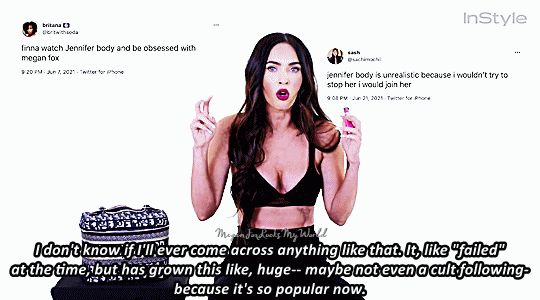Text










Bicon, Megan Fox geeking out over Jennifer's Body and its legacy.
36K notes
·
View notes
Text
Fabric types
Introduction:
Whether you're sorting out your fabric stash, buying new clothes, or planning a sewing project, it's always a good idea to have some basic knowledge about fabric types.
This post is not a full guide. There's plenty of fabrics that have been left out, like bamboo or pleather. However, this post will give you some idea of the most common types of fabric you'll find when shopping or when cleaning out your stash.
Fabric types:
First of all, there's two major types of fabrics: woven and knit. Broadly speaking, woven fabrics have threads that crisscross each other, and aren't elastic. Knit fabrics have threads that loop into each other, and are elastic.
Fabrics can also be combined with each other. For example, a lot of commercially available t-shirts are a cotton/polyester blend.

(Image source)

(Image source)
Now, let's take a look at a few specific fabrics!
Cotton: cotton is a woven natural fibre, and currently one of the most commonly used materials in fashion, along with polyester. It's soft and breathable. Overall, it's a good choice if you don't know what to use and need something that's not stretchy. Cotton can be woven in many different ways, resulting in different fabrics such as denim or chambray.
Linen: linen is another woven natural fibre, made from flax. It's a great choice for warm weather clothing, as it dries fast and keeps you cool. However, it wrinkles easily and requires specific care instructions if you want to keep it wrinkle-free.
Silk: silk is a woven natural fibre made of the cocoons of the silk worm. Silk costs a pretty penny, but is also one of the strongest fabrics in existence. It's smooth, breathable, shiny, and is commonly used for lingerie and evening wear, among others.
Flannel: flannel is a soft, fuzzy fabric that will keep you warm. While originally made of wool, it can be woven out of wool, cotton, or synthetic fibres these days. Flannel is often used for cold weather wear, sleepwear, and blankets.
Jersey: jersey is a knit fabric, and therefore very stretchy. It can be made of wool, cotton, or synthetic fibres. Your t-shirts are probably made out of jersey fabric. It's also commonly used for sweatshirts, underwear, sportswear, and many other types of garments.
Hemp: hemp is a natural woven fibre and is part of the cannabis family. It's a fast growing plant that results in a strong, breathable fabric. Hemp can be used to make clothes in similar ways as cotton and linen.
Denim: denim is a sturdy fabric made with cotton. It's breathable, and can be quite stiff. Its most common application are jeans, but it can be used to make a variety of clothes and accessories.
Wool: wool is a natural fibre obtained from sheep, and other animals such as goats or rabbits. Wool is harvested by shearing these animals, and if this is done properly, the animal will not be harmed. It keeps you warm when the weather's cold, and cold when it's warm. Wool is commonly used for cold weather clothing and is a popular knitting material. It needs extra care when washing as it can shrink and felt if not taken care of properly. Be careful when using sheep's wool as it can trigger allergies in some people, and others may find it itchy.
Leather: leather is a strong, flexible material made by tanning animal skin. Good quality leather will last for decades. It's commonly used for footwear, clothes, and accessories, among others. If you're looking for an alternative to leather, please pick a sustainable leather alternative and do not use faux leather made with polyurethane as it's basically plastic.
Satin: satin isn't a fibre, but a weaving technique that produces a soft, smooth fabric. Satin weaves can be made with a variety of materials like cotton, silk, and polyester. Satin is often used for evening wear, lingerie, bed sheets, and as lining for clothes.
Chiffon: chiffon is a lightweight, translucent fabric. It was originally made of silk, but polyester chiffon is the most common type today. Chiffon is often used as an overlay for clothing, and for blouses, lingerie, scarves, and anything else that requires something lightweight and see-through.
Velvet: velvet is a woven, tufted fabric that feels very soft. You're probably familiar with this fabric if you enjoy Gothic fashion. Velvet was originally made of silk, but today's velvet is usually made with either cotton or synthetic fibres such as polyester, nylon, viscose, or rayon.
Rayon: rayon is a synthetic fibre made from a natural resource: cellulose. It's a very soft fabric that can be used to make a wide variety of clothes. Rayon's a bit of a mixed bag when it comes to sustainability: it's biodegradable, but its production process isn't pretty. It also requires specific care instructions to keep it in good shape.
Nylon: nylon is a synthetic fibre that's probably best known for its use to make hosiery. It's also used for other types of form-fitting clothing, and for sportswear. While nylon is a very strong and elastic material, it doesn't breath well and attracts static electricity. Nylon is one of those fabrics that's basically plastic.
Polyester: polyester is a very common synthetic fibre. A large part of the clothes you'll find in a fast fashion shop are made of (a blend containing) polyester. Polyester can be used for anything that could also be made of cotton: in fact, cotton and polyester are often combined into one fabric. Polyester is durable and moisture resistant, but it doesn't breath well and is basically plastic.
Conclusion:
If you're wondering which one of these fabrics you'd like wearing the most, there's an easy answer: go to your wardrobe, and check the labels inside of your clothes. These labels will mention what fabrics your clothes are made of. If there's a specific fabric that shows up a lot in your closet, you probably really like that fabric. If there's an item you particularly love for its sensory characteristics, check its label, too: you'll probably love the fabric this item was made with.
Next time you buy clothes, keep these fabrics in mind. If you buy something made from a fabric you love, you're more likely to wear it.
If you currently have a lot of synthetic or unsustainable fabrics in your closet, don't worry. It's better to wear these items until they break down than to throw them out while they're still usable, even if you replace them with sustainable alternatives. Wasting pre-existing materials is bad for the environment. They've already been made, you can't undo that. Do replace them with sustainable alternatives once they break down if you can, though!
If you want to take a closer look at fabrics, I recommend The Closet Historian's video on how to choose fabrics for sewing projects, or Nicole Rudolph's YouTube channel. Nicole's currently doing a detailed video series on fabrics.
1K notes
·
View notes
Photo




Handmade quilt ii. in progress
insta | youtube
600 notes
·
View notes
Text





My Etsy shop is live! Here are detail shots of my first few items. Reblogs and likes greatly appreciated since I have a small following! I'll be adding new items weekly.
https://www.etsy.com/shop/RinkujutsuCostumes
I'll be selling a variety of geeky and crafty items with a focus on Zelda stuff. I also have some of my cosplay prop blueprints on there and have plans to develop a full range of cosplay patterns in standard and plus sizes. But anyway, these are my handmade Age of Calamity and Breath of the Wild themed embroidered face masks and white jean jacket 😃
My facemasks are made with two layers of soft, high thread count cotton, a layer of non-woven polypropylene that acts as a water repellent filter, adjustable ear elastic, and sturdy armature wire. I did a lot of research to determine the most effective and comfortable combination of materials and reflected what I'd tweak based on my own experience wearing them. The result is super soft, comfy, and breathable! Keep an eye out for more shop items soon!
356 notes
·
View notes
Text




pictures of a Harris Tweed skirt i recently made!
32 notes
·
View notes
Text
Fire Emblem Hilda Cosplay (Part 1)
This is a project that I have been SO excited about for so long now and I’ve been working on it but by bit over the last couple months. I just thought this would be the perfect cosplay to do (if I can ever go to a real life convention ever again yikes) for pretty much one reason: I have pink hair it is so cool.
I really wanted to try drafting this whole costume from scratch, using as little outside help as possible because I like to make things harder for myself. This meant that my first step was to do a few concept sketches of the costume to try and break down the different components in it.

I started by doing a full body sketch on tracing paper and then adding another sheet of tracing paper underneath that to block out color. I really like using a more dynamic pose for this step because I feel like it gives me a better feel and understanding of the piece. Off to the side I also blocked out the colors that appeared in the costume.
BTW if you too are a real human with a normal human body like me and you are tired of seeing all these stick thin croquis being used for garment drawings go to tracingrealbodymodels.org !!! It’s a seriously great website that makes fashion templates out of user-submitted photos!!!!!!

I then broke up the costume into each individual layer by tracing off of the main figure, so that I could see how many pieces I had to make. A really easy way to make the back view of a piece is to trace and outline of the front view and just draw in the back details. You can tell that in mine the front and back view have the same shape with a few adjustments here and there.
Actual construction begins in the next part!
9 notes
·
View notes
Text
Hand Sewing a 18th Century Chemise á la Reine Inspired Dress (Part 1)
This process is only kinda based on instruction from tons of very talented historical seamstresses on the internet and is mostly just me making educated guesses and messing around until something sticks. therefore this has, like, zero historical value.
I’m not quite sure what possessed me to want to hand sew an entire dress when I have a perfectly fine sewing machine, but here I am and I have already committed to it.
From what I learned from a little research, chemise á la reine dresses were usually made out of a very lightweight sheer cotton, which is what I chose to do. This is just some cotton/linen blend.

This meant that I had to make some kind of lining, or wouldn’t you know it, a chemise. I opted for the chemise because historical accuracy? I made this out of a bleached cotton muslin.
To make the skirt I just used my waist measurement and waist-to-floor length to trace out 2 trapezoids, which I then stitched together with a running backstitch.

This is my drafting, if you can make any sense of it.

After this, I had to think about how I wanted the top of the lining chemise. I decided to make something loose so that it could be easily be put on.
Once again, my confusing drafting:

The idea is that the back of the chemise would be open with a few ties to secure it. So, I cut out a large rectangle of the muslin (73 1/4″ x 9 3/4″). The one pictured is folded over length-wise four times.

I then unfolded my absurd rectangle and began sewing a very loose stitch on both long edges of the fabric to gather with. This very loose baste stitch gave the gathering more of a pleated look which was kinda cool looking but it was kinda a nightmare to hand stitch and if I ever do this again in the future I will just do a tighter stitch.

Once I finished this, I gathered the bottom edge to match the waist of my skirt, and the top edge to match with my upper bust, where I wanted the neckline to fall.

This post is already long enough so I will end this part here. More to come later hopefully!
#sewing#historical sewing#but is it really?#hand sewing#chemise a la reine#current project#dressmaking#fashion
10 notes
·
View notes

